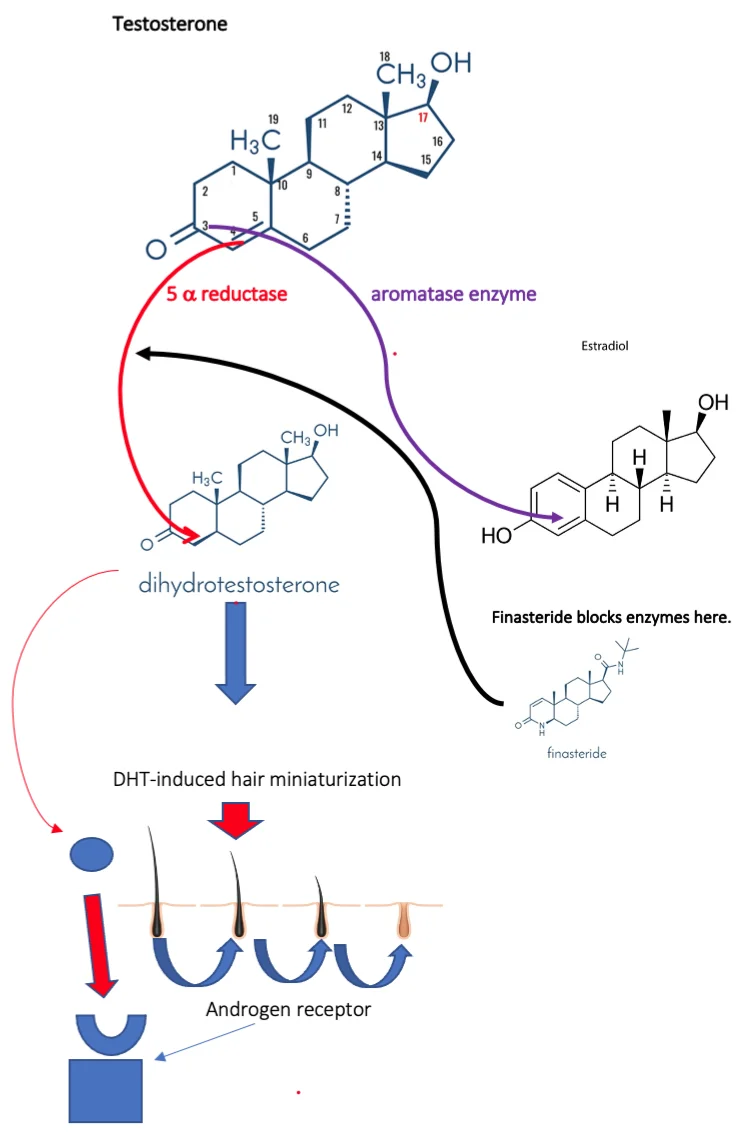What is DHT? Whenever the topic of hair loss is brought up, these three letters are found not far behind, but what do they stand for?
DHT or Dihydrotestosterone
DHT stands for dihydrotestosterone and is an active metabolite or derivative of testosterone. DHT is much more potent than its parent testosterone and binds more strongly with the androgen receptor. Think of the androgen receptor and the hormones of testosterone and DHT as keys with the locks being the androgen receptor. When the key is in the lock, or when the testosterone or DHT binds to the androgen receptor, we then get all the wonderful and not-so-wonderful benefits of these hormones.
To learn about how DHT then goes on to cause hair loss, it’s good to get to grips with these hormones at a molecular level and yes that means those chemical formulas you used to love at school.
DHT and testosterone

The 5 alpha reductase enzyme
From the above, you can see that the 5a reductase works on the double bond on carbon 5 (the name kind of gives it away!) to break it open while the aromatase enzyme throws in a few more double bonds.
Ok, I think that’s enough chemistry, but now you know where this all happens on the molecule…how it happens is a job for those of us with PhDs in chemistry. Anyway, I digress…what does this have to do with hair loss?
DHT and hair loss
5a reductase enzymes are found in the skin, prostate and hair follicles (Harris, G., Azzolina, B et al 1992) where they transform testosterone into the more potent DHT. This DHT then acts on the androgen receptor on the hair follicle and causes hair miniaturisation (Kaufman, K.D., 2002). This is when the hair gets gradually thinner, shorter and weaker over time until the hair returns to the smaller and finer vellus-type hair and becomes dormant and unable to grow.
Even though all men have DHT not all are affected by baldness (lucky so and so’s). Hair loss caused by androgenetic alopecia (the technical term) occurs only if you are genetically predisposed to male pattern baldness.
Finasteride and male pattern baldness
Hence, to stop the process of male pattern baldness scientists have developed drugs to inhibit the 5a reductase enzyme. The one that you are probably familiar with is called finasteride.
So, if DHT cannot negatively affect the hair follicle we can thus prevent, or at the very least slow down the hair loss in androgenetic alopecia.
Where can I buy finasteride for male pattern baldness?
If you are starting to notice the characteristic thinning and loss of hair associated with male pattern baldness, then the sooner you do something about it, the better the results.
You can either purchase the finasteride 1mg generic tablets or the branded Propecia 1mg from Medical Mojo. Or if you prefer you could try the compounded option of the finasteride 0.1% minoxidil 10% hair loss solution or foam.

References:
- Harris, G., Azzolina, B., Baginsky, W., Cimis, G., Rasmusson, G.H., Tolman, R.L., Raetz, C.R. and Ellsworth, K., 1992. Identification and selective inhibition of an isozyme of steroid 5 alpha-reductase in human scalp. Proceedings of the National Academy of Sciences, 89(22), pp.10787-10791.
- Kaufman, K.D., 2002. Androgens and alopecia. Molecular and cellular endocrinology, 1984(1-2), pp.89-95.


